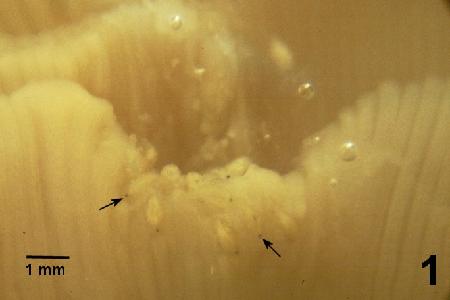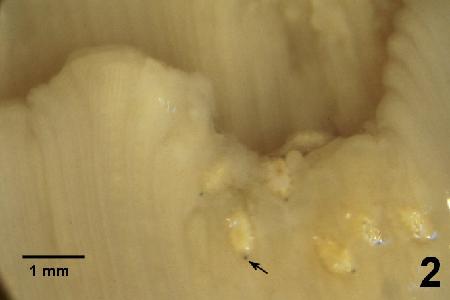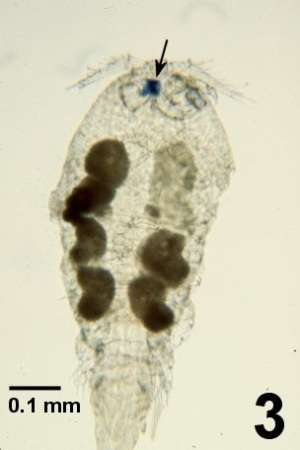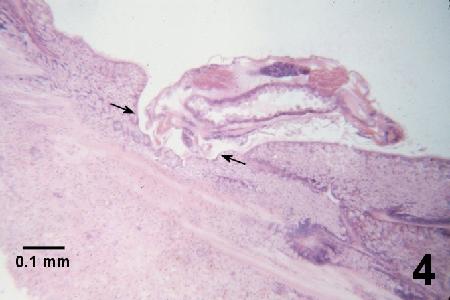Parasitic Copepods on Oyster Gills
On this page
Category
Category 4 (Negligible Regulatory Significance in Canada)
Common, generally accepted names of the organism or disease agent
Parasitic copepods attached to gills.
Scientific name or taxonomic affiliation
Several species of parasitic copepods in the genera Modiolicola, Ostrincola, Pseudomyicola, Lichomolgus, Conchyliurus, Myocheres, Paranthessius and Myicola. The species Herrmannella duggani was found associated with Ostrea edulis that were exhibiting an abnormal gill condition on the west coast of Ireland (Holmes and Minchin 1991).
Geographic distribution
Reported from Europe, eastern and western United States as well as British Columbia. Various species probably have limited distribution.
Host species
Crassostrea virginica, Crassostrea gigas, Crassostrea angulata and Ostrea edulis, Ostrea tulipa and other species of bivalves.
Impact on the host
The vast majority of species are innocuous due to the low prevalence and intensity of infection, despite the fact that most species are strongly attached to the gills. However, Myicola ostreae causes gill lesions in C. gigas and C. angulata in France and Ostrincola sp. has caused severe gill erosion in a remnant introduced population of C. virginica in British Columbia. Herrmannella duggani was reported from O. edulis which had gills reduced in size (by about 20% and occasionally with more than 50% of the gills missing) and indented gill margins.
Diagnostic techniques
Squash Preparations
Parasitic copepods can be observed attached to dissected gills pressed between two plexiglass plates and examined under a dissecting microscope (50x).


Figures 1 and 2. Wet mount preparations showing gill erosion in Crassostrea virginica associated with Ostrincola sp. evident by the pigmented ocellus (eyespot, arrows).

Figure 3. Wet mount of Ostrincola sp., family Myicolidae (preserved specimens identified by Dr. A.G. Humes, Boston University, Marine Biological Laboratory, Woods Hole, MS, USA in 1989) with a central, pigmented ocellus (arrow). This copepod was removed from Crassostrea virginica collected in Boundary Bay, B.C., Canada. Apparently some species in this genus of copepod secrete enzymes that dissolve the tissue (gills) to which it is attached and then consumes the resulting slurry.
Histology
Cross sections of copepods attached to the gills.

Figure 4. Histological section of the gill of Crassostrea virginica, showing erosion (between arrows) and associated haemocytic infiltration caused by Ostrincola sp. Haematoxylin and eosin stain.
Methods of control
No known methods of prevention or control.
References
Cheng, T.C. 1967. Marine molluscs as hosts for symbioses with a review of known parasites of commercially important species. In: F.S. Russell (ed.) Advances in Marine Biology. Volume 5. Academic Press Inc., London, p. 296-315.
Holmes, J.M.C. and D. Minchin. 1991. A new species of Herrmannella (Copepoda, Poecilostomatoida, Sabelliphilidae) associated with the oyster Ostrea edulis L. Crustaceana 60: 258-269.
Lauckner, G. 1983. Diseases of Mollusca: Bivalvia. In: O. Kinne (ed.) Diseases of Marine Animals. Volume II: Introduction, Bivalvia to Scaphopoda. Biologische Anstalt Helgoland, Hamburg, p. 817-833.
Marteil, L. 1976. La conchyliculture française, 2 partie: biologie de l'huitre et de la moule. Chapitre VI: maladies et mortalites. Revue des Travaux de l'Institut des Pêches Maritimes. 40: 285-313. (In French)
Citation Information
Bower, S.M. (2002): Synopsis of Infectious Diseases and Parasites of Commercially Exploited Shellfish: Parasitic Copepods on Oyster Gills.
Date last revised: April 2002
Comments to Susan Bower
- Date modified: